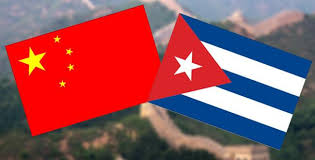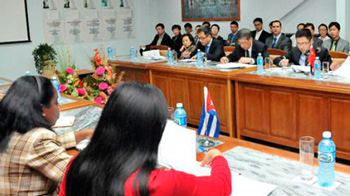The History and Future of Cuba–China Ties
By Pilar Montes

HAVANA TIMES — Fifty years ago, China was still very far away from the Caribbean. It had no visible economic development or any evident reason to buy or invest in Latin America.
Though its geographic distance from this part of the world hasn’t decreased, today our markets are moved by its trade, cooperation initiatives and investments.
China’s commercial airline authorities have even announced that regular flights from Peking to Havana (with a stopover in Canada) will begin this year.
During the 27th Cuba-China Intergovernmental Commission, held in Havana from January 26 to 28, five new agreements (in the areas of agriculture, telecommunications, trade, finances, industry and transportation) were signed, confirming China’s and Cuba’s interest in strengthening and expanding their economic relations.
Today, the People’s Republic of China is Cuba’s second most important commercial partner, second only to Venezuela. In 2013, trade with China accounted for some US $ 1.8 billion, and this figure continues to grow.
According to official figures, as of this year, following the signing of new agreements, trade with China could be expanded by 25 percent.
Cuba’s proposal regarding the payment of its debt with China was also officially approved, a show of the country’s confidence in the Cuban market.

Hoping to carry out an in-depth analysis of this Asian giant, I interviewed PhD in Economics Julio A. Diaz Vazquez, from the International Economy Research Center attached to the University of Havana.
Diaz informed me that the main component of bilateral trade between Cuba and China are exports, primarily in nickel, sugar, seafood, citric fruits, scrap metal, tobacco, biotechnology products and rum.
Cuba, in turn, imports different kinds of machinery, household appliances, energy-saving bulbs, textiles products, vehicles and other means of transportation, footwear and food from China.
First Contact
Diaz points out that, following the approval of the First Havana Declaration on September 2, 1960, Cuba announced it was breaking relations with Taiwan and establishing ties with the People’s Republic of China. On September 28, 1960, a Joint Communiqué was to announce the incipient ties between China and Cuba.
Economic exchange between the two countries would begin to take shape following Ernesto Che Guevara’s visit to China in 1961.
These new ties led to the signing of the first Economic and Technological Cooperation Agreement and the granting of a 40-million-dollar credit (without interest) for the purchase of equipment and other goods from China.
These economic ties were established when the US blockade on Cuba was threatening the revolution’s very survival. The first Latin American leader to visit China was in fact Cuban President Osvaldo Dorticos, who traveled there in 1961.
These economic relations evinced a modest upward trend until the close of 1965, Diaz Vazquez explained. When the People’s Republic of China entered its Cultural Revolution, trade with Cuba was maintained: between 800 thousand and a million tons of sugar would be exchanged for a broad range of products through the world market.

Modest levels of trade in such products as rice, textiles, power generators, steel wiring, chemical products, paper, raw pharmaceutical materials, medicine, tools and consumer items, were maintained until 1985.
According to Diaz Vazquez, the Intergovernmental Commission for Economic and Commercial Relations (CMIREC) was established in 1988 and held its first work session that same year. The following year, sugar (which accounted for more than 73 percent of the country’s commercial activities) was the main product exported by Cuba.
The remaining percentage was made up of nickel oxide sinter, tobacco, citrics and other products sold to China.
Joint initiatives led to the search for new forms of bilateral trade and studies aimed at introducing Cuban biotechnology products into the Asian giant.
The collapse of European socialism and disintegration of the USSR from 1989 to 1991, in addition to the sudden rupturing of the economic and political ties Cuba had developed with this bloc for 30 years, led to the intensification of the US blockade on Cuba.
Referring to the current state of Cuba-China relations, Diaz Vazquez explained that the two countries are facing challenges that will demand considerable effort, understanding and work at both ends.
Encouraging joint investment, becoming more aware of each country’s realities, training the professionals involved in negotiations and the selection of adequate partnerships are urgently needed, Diaz Vazquez pointed out.
In his opinion, the main obstacle to be overcome concerns the broadening of the range of products Cuba sells in China’s market.
It would be positive, he said, if the increase in nickel sales were accompanied by an increase in the number of different products exported by Cuba, including sugar, an industry which is being revived on the island.
This is decisive in terms of achieving a trade balance between the two countries, Diaz Vazquez added.
The Search for Investors
In addition, large Chinese corporations are clearly making forays into international markets. One of Cuba’s weaknesses in terms of economic relations between the two countries is linked, today, to the shortage of Chinese investors on the island.
This has to do with the poor and limited business experience that continues to prevail in Cuba. To make positive strides and tap the potential of the island’s market in the near future, existing barriers must be overcome and new links between China and Cuba must be established.
Lastly, the expert on Cuba-China relations explained that other obstacles that must be overcome include shortages, existing inefficiency in Cuban companies and the country’s scant economic development.
Improving these factors, coupled with the 2014 Foreign Investment Law, will draw foreign investors and introduce them into the market through well-defined policies that will avoid the mistakes of the past.

I have a dream for you: Consider this, In an effort to provide the world with the best,
Cuban- Chinese built and designed Solar Charging Electric transports. The latest technology will support this , I am a certified solar panel installer and have worked with many electric transportation designs so from where I am standing the dream is a reality. The units could be grouped at charging stations with rationed use free( a different kind of freedom like health care) and regulated for the common good so all can benefit from their use and “0” pollution and smog.
Manufactured in Cuba , readily available to the markets of those nations whom would benefit the most from less smog. It is a no brainer.
Think about it !
Thank You
The Chinese are not known for supporting dependency states. They are the world’s best traders. It will sharpen the Cuban’s competiveness in international deal making.
China is more capitalist than the U.S. , that will be a challenge as the two economic systems interact. The Cuban’s will find that China business does not invest without a profit. They are not in the charity business.
The Chinese have a long history in Cuba. After slavery was abolished 120,000 Chinese male were brought to Cuba as cheap labour. Many Chinese came to Cuba after they built the Canadin Pacific Railway. After completion of the railway many of the Chinese returned to China and some relocated to the USA. A few did marry into the European and African community. Less than 500 pure Chinese still live in Cuba but new Chinese do work in the oil fields / off shore near Varadero.